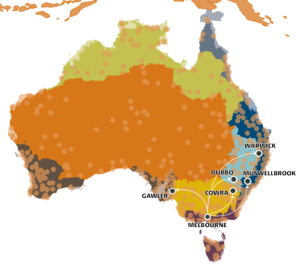Some of Melbourne’s climate analogues for 2090 under a high emission scenario
We all have an interest in whether rain will dampen our day and a curiosity about what the skies hold for next week. We are all impacted when the weather turns extreme, sometimes in devastating ways. And we have a yearning to know what the future might hold for our climate, so that we can plan ahead.
Weather and climate may never be completely predictable, but science has come far enough for us to be breaking new ground when it comes to projecting what Australia’s climate may look like decades – or even hundreds of years – in the future.
And here’s a sneak peak into the future – by the year 2090, Sydney could have the climate of Brisbane, and Melbourne could have the climate of Dubbo.
Climate models help us to understand our present weather and climate, and also allow us to consider plausible future scenarios of how the climate might change. Climate models are built using mathematical representations of the dynamic Earth system. Their fundamentals are based on the laws of physics including conservation of mass, energy and momentum. They create simulations to tell us what happened or what might happen under a range of different scenarios (such as greenhouse gas concentrations).
Check out this animation about climate models.
Along with the Bureau of Meteorology, we’ve used as many as 40 climate models, produced by international global climate modelling groups, to create projections for Australia’s climate, all the way out to the year 2090. The projections consider up to 15 regions of Australia, a small set of plausible future greenhouse gas scenarios and four future time periods.
Climate change projections are presented as a range of possibilities. This occurs because different models produce different projections. Even though they are based on the same physical laws, such as conservation of mass, moisture and energy, each climate model treats regional processes in the oceans and atmosphere slightly differently. It is important to explore the full range of possibilities in any impact assessment.
Even if we significantly reduce our greenhouse gas emissions as under an intermediate scenario, Melbourne’s annual average climate could look more like that of Adelaide’s, and Adelaide’s climate could be more like that of Griffith in New South Wales.
Eastern Australian coastal sites could see a climate shift to those currently typical of locations hundreds of kilometres north along the coast. Sydney’s climate could resemble that of Port Macquarie, and Coffs Harbour’s climate resembling that of the Gold Coast (by 2050; intermediate emissions).
These analogues, and others for more than 400 towns, can be found using a climate analogues tool – one of 13 tools that can be found on the Climate Change in Australia website.
This research received funding from the Department of Environment under the Regional Natural Resource Management Planning for Climate Change Fund. Additional funding was provided by CSIRO and the Bureau of Meteorology.
We have published a few articles over on The Conversation which takes a deeper look into the details of these climate models and projections.



21st February 2016 at 4:22 pm
It’s a pity that all 40 climate models have failed so miserably in predicting climate in recent years.
http://www.cfact.org/2013/11/03/consensus-revealed-climate-computer-models-warmer-than-reality/
5th May 2015 at 3:46 pm
Really Pam, you took time out of your day to write that?
Remember where you are posting your comments……
Denial of sound science to further some ill conceived agenda isn’t going to fool too many in this audience.
18th April 2015 at 11:10 am
Mere projections of guesses with less than a 50-50 chance of being right. Climate change? When does it not? Whoever guaranteed that ANYTHING on Earth wouldn’t change?
11th April 2015 at 11:08 am
Can you provide the links to The Conversation articles that give more depth on your climate models.
13th April 2015 at 10:04 am
Hi Debbie
We have provided links to the two articles that have been published on The Conversation thus far.
Thanks
Nick
CSIRO Social Media Team
10th April 2015 at 4:55 pm
All these models rely on various degrees of warming due to greenhouse carbon dioxide – depending upon which model is chosen. The fact that there is a scatter of models implies that no such relationship between carbon dioxide level and warming has been settled upon.
My site pjcarson2015.wordpress.com determines such a quantitative relationship.
(It also discusses other climate issues; so far, most importantly, cyclones such as the recent Pam. The site is continuously updated.)